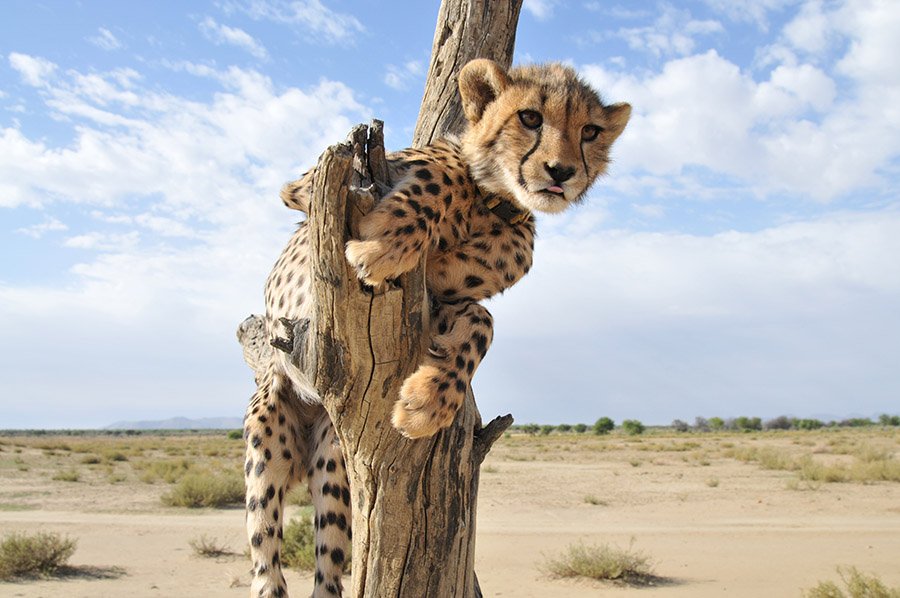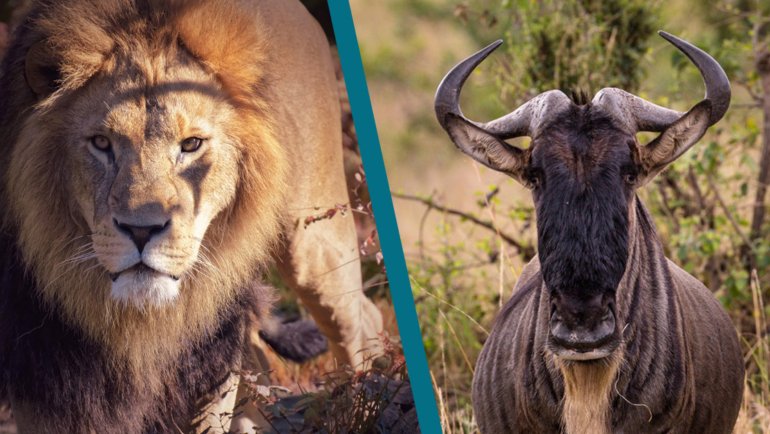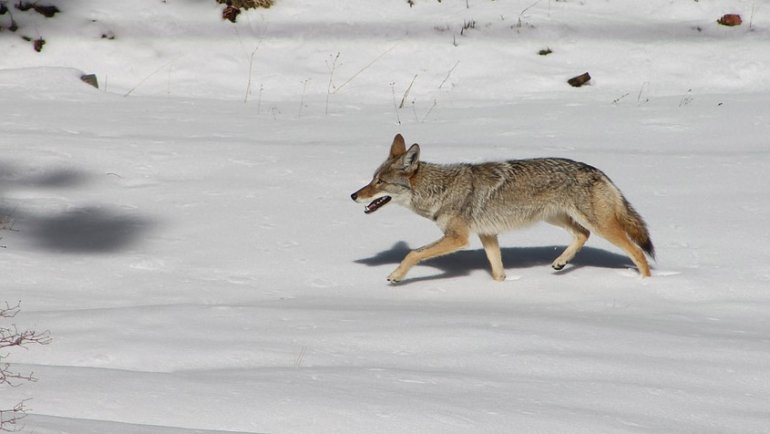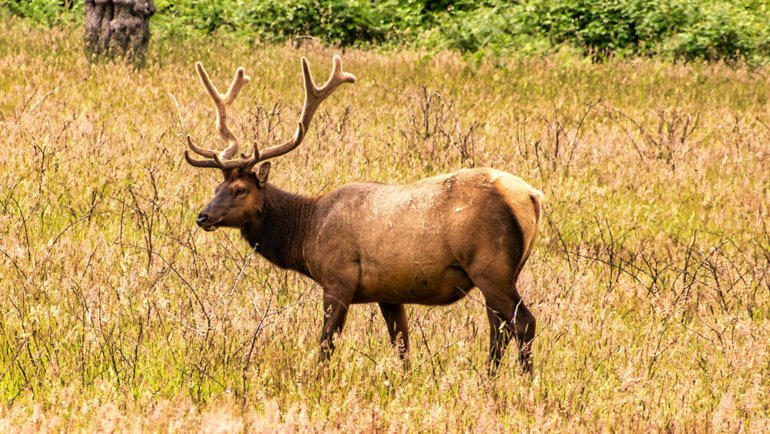Due to the close resemblance with their cousins in the Felidae family, leopards, who are known to be excellent tree climbers, it’s common for people to compare them by asking, ‘can cheetahs also climb trees?’
Therefore, this article will address this query while shedding light on other similar factors related to this topic.
Can Cheetahs Climb Trees?
Yes, these felines can climb trees and occasionally do so. However, they prefer to maintain and conduct most of their activities on the ground and only do so if substantial reasons require them to climb a tree.
Why Do Cheetahs Climb Trees?
Below are the main reasons that make this big cat climb a tree.
To Play and Exercise
The cat’s cubs are the main tree climbers due to their small size and playful character. Tree climbing is ideal for mothers and their offspring to engage in fun/playful bonding activities while simultaneously exercising their developing leg muscles.
It’s rare to find male or female cheetahs without cubs climbing trees in their free time as a leisure activity. Instead, they prefer relaxing under the trees’ shade.

To Mark Their Territory
All big cats, including cheetahs, are territorial animals. These cats always claim their occupied habitat by marking it. It is to inform others that the territory has its owner, and they are not welcome. They mark their territories by urinating and defecating (leaving their feces) over specific zones.
Trees serve as great landmarks; hence if there is any such vegetation present, a cheetah will scratch its barks as it climbs and also urinate on it on its way up/down as a way of marking the area surrounding the tree.
Also read: Are Cheetahs Dangerous? Do They Attack Humans?
To Survey Their Territory
Another significant advantage of trees in a cheetah’s territory is their elevation, providing a better view of its territory.
Therefore, it will climb the vegetation to survey its habitat for potential prey, mates, and intruders/enemies. This act will give it a wide and clear view of its surrounding environment since it can easily spot any of these factors.
Hunting
Cheetahs are among the most determined predators; hence if they spot potential prey, such as a bird or a vulnerable monkey, on top of a tree, they will try to climb and capture it.
Shelter and Refuge
Unfortunately, cheetahs have powerful enemies in the wild such as lions and hyenas. When they encounter them, apart from using their fast-speed capability to flee, they also climb the nearest tree to seek refuge.

This defensive mechanism is usually applied when they have hunted a prey, but as they are devouring it, an enemy appears, chases it, and takes over the meal.
When this happens, they may seek refuge by climbing the nearest tree (close to the carcass), wait for the enemy to eat to its satisfaction, and leave the remainder (common with lions).
Also read: Cheetah vs. Jaguar: Key Differences & Who Would Win a Fight?
When the enemy leaves the vicinity, they will climb down and try to salvage what is left. However, when it comes to hyenas, there are slim chances of finding any remains; hence it usually waits for them to leave (when it’s safe).
Although rare, cheetahs ascend to lower tree branches found in their territories to relax, sleep/nap. It usually resorts to this option if it knows its habitat has powerful enemies like the lion.
Therefore, it will prefer the comfort of tree tops where it’s much safer, but when it feels that there is no threat nearby, it would rather stay on the ground, under the tree’s shade.
How Do Cheetahs Climb Trees?
Using Their Weak and Semi-Retractable Claws
Unlike leopards with strong and sharp claws, which make them excellent tree climbers, cheetahs have weak and semi-retractable claws in their feet, which it uses to grip and climb trees.
Using Their Rough Paws
These felines have very rough paw pads in their limbs, which enables them to create sufficient traction with their respective surface. It’s among the valuable feature that allows the cat to run at high speeds and make sharp corners without falling due to their firm grip on the ground.
Fortunately, this unique body feature also helps them climb trees by maintaining a firm grip on the tree’s bark.
Its Small Body Weight and Long Tail
Cheetahs have a lean body frame, strong legs, smaller body weight (an adult weighs approximately (75- 130 lbs/34-59 kg), and long tails (24-34 inches/61-86 cm), which makes it easier for the cat to ascend to the tree tops.
Therefore, the feline’s weight doesn’t hinder it from climbing, while its long tail helps it maintain the required balance.
Also read: How Many Spots Does a Cheetah Have?
Do Cheetahs Climb Trees With Prey?
No, cheetahs don’t climb trees with their prey (unless it’s very small, which is a rare occurrence worth considering) since they are not excellent tree climbers, nor do they have powerful jaws compared to leopards.
Therefore, they prefer to feed on their prey while they are on the ground. When they face/encounter threats from other animals, they usually abandon their meal and flee for safety thanks to their high-speed capability.

Why Can’t Cheetahs Climb Very High Trees?
The limiting factors that prevent cheetahs from climbing very high trees include the following:
- Cheetahs have weak and semi-retractable claws that lack enough strength to enable them to climb higher.
- Their legs are not muscular and strong enough since climbing trees requires more effort and power. It’s essential to note that by ascending, one is going in the opposite direction of the earth’s gravitational force; hence it requires higher energy levels to overcome it.
- Their speed makes them more adaptable to the earth’s surface; hence they prefer staying on the ground than climbing to the tree tops. They are terrestrial and not arboreal animals!
Frequently Asked Questions About Cheetahs
How Long Do Cheetahs Live?
The average lifespan of a wild cheetah is 10-12 years, while those in captivity may live 12-15 years.
How Fast Are Cheetahs?
An adult cheetah can attain a 60-75 mph (97-121 km/h) speed only in shorter distances of up to 0.30 miles (483 meters). After that, it decelerates to 40 mph (64 km/h) for a distance of less than 500 meters.
However, the fastest cheetah, Sarah, in Ohio, USA (Cincinnati Zoo), achieved a speed of 61 mph in 5.95 seconds at a distance of 100 meters.
What is a Group of Cheetahs Called?
Females are solitary unless they have cubs, but male cheetahs live and hunt in groups of two to three, known as a ‘Coalition.’
How Many Cheetahs Are Left in The World?
According to the latest statistics from the IUCN (International Union for the Conservation of Nature) Red List, there are currently 6,517- 7,000 wild cheetahs. In total, including those in captivity, they are estimated to be less than 7100 cheetahs globally.
Frequently Asked Questions About Climbing Trees
Can Leopards Climb Trees?
Yes, leopards climb trees; they are the best tree climbers in the big cat family. They are often seen carrying their prey up the trees to keep it safe from other predators.
Can Lions Climb Trees?
No, lions are not excellent tree climbers; when they do so (rarely), they only reach shorter heights; after struggling due to their significant weight.
Can Jaguars Climb Trees?
Yes, jaguars are also great tree climbers and are usually spotted relaxing/napping at tree tops. Their strong and muscular hind legs enable them to thrust their bodies higher, and their sharp retractable claws help them maintain a firm grip while climbing trees.
Can Hyenas Climb Trees?
No, hyenas cannot climb trees since they lack all the necessary features to achieve this task. Their claws are not long and sharp enough, nor are they retractable to give them a firm grip on the tree surfaces.
They have short and weak front limbs, while most of their body weight is concentrated on their lower abdomen, making it extremely hard to support it while climbing a tree.
Can Tigers Climb Trees?
Despite their significant body size and weight, tigers are great tree climbers, especially young ones. They have strong legs, sharp claws, and a long tail to help them balance while climbing.
Final Thoughts
As you’ve seen, although they can climb trees, especially at shorter heights, they rarely do so. Instead, cheetahs prefer conducting their activities on the ground where they can utilize their unique talents, which is being the fastest land animal.
Other Articles to Learn More About Cheetahs
- Cheetah: Characteristics, Diet, Facts & More [Fact Sheet]
- Cheetah Sounds: What Sounds Do Cheetahs Make, Why and When?
- How Strong is a Cheetah? How Do They Compare With Other Big Cats?
- How Many Types of Cheetahs Are There? A Look at Their Different Subspecies
- What Do Baby Cheetahs Eat? A Fascinating Look At Their Diet
- What is a Group of Cheetahs Called? Do They Always Live in Groups?
- How Long Do Cheetahs Live? All About Cheetahs’ Lifespan and Life Cycle



